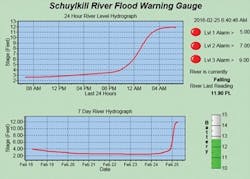Pennsylvania Township Sends Flood Warnings Via Twitter
This case study is an example of real-time measurements that result in the distribution of alarm conditions via email and Twitter using Campbell Scientific hardware. The project also has a website hosted by the data logger to allow interested parties to see current conditions and provide context for alarm conditions.
The Schuylkill River, located in central and eastern Pennsylvania, is roughly 130 miles long and has a drainage area of 2,000 sq miles. About 25 miles upstream of where it joins the Delaware River is Upper Providence Township. Knowing the flooding history along this stretch of the river, township officials identified the need for a local, automated gaging station that would provide real-time information and updates about river water levels. The fire department and emergency management office worked with Distinctive AFWS Designs to design and build a station that met their needs. It was concluded that the most effective design would be a gaging station with a built-in web page and notification system.
The gaging station consists of a Campbell Scientific CR6 data logger, CS451 submersible pressure transducer, battery and solar charging system, and RavenXT cellular modem. Water level is measured every 10 seconds and the data logger records 1- and 5-minute interval averages of the measurements (to dampen out surface turbulence). The logged data are used to populate the station’s internal web page. The web page returns current readings, long-term trends and alarm states to aid in decision making.
Anytime the water level reaches a defined alarm threshold, the data logger sends out level-specific email and text notifications to emergency responders and public officials. The email and text group list is maintained by the emergency management staff on their email server, not in the gaging station. As a means of ensuring proper operation, each day at noon a heartbeat email is sent out to selected individuals. Maintenance-related notifications, such as low battery or intrusion, also can be sent out.
The second page of the station’s web page includes impact statements related to the measured and reported water levels. The elevations for impact were determined after a professional survey was conducted of key hazard points along the river and related back to the water levels that would be measured at the gage.
All of this information was intended for emergency responders and public officials. However, recent extreme flooding events have shown that social media is an
important medium for informing the general public about hazardous conditions. Therefore, a Twitter account (@fwg_schuylkill) was created for the gaging station and was configured to send out hourly tweets of the current river level, as well as tweet whenever an alarm threshold is reached.
Anyone can follow the Twitter page, and hashtags will be embedded in appropriate tweets to better enable followers to stay informed. The team is working to improve the automated tweeting experience and information presentation through the use of Internet of Things platforms. There are other potential uses and applications for getting gaging station information directly to the general public via social media or traditional flood warning systems.


